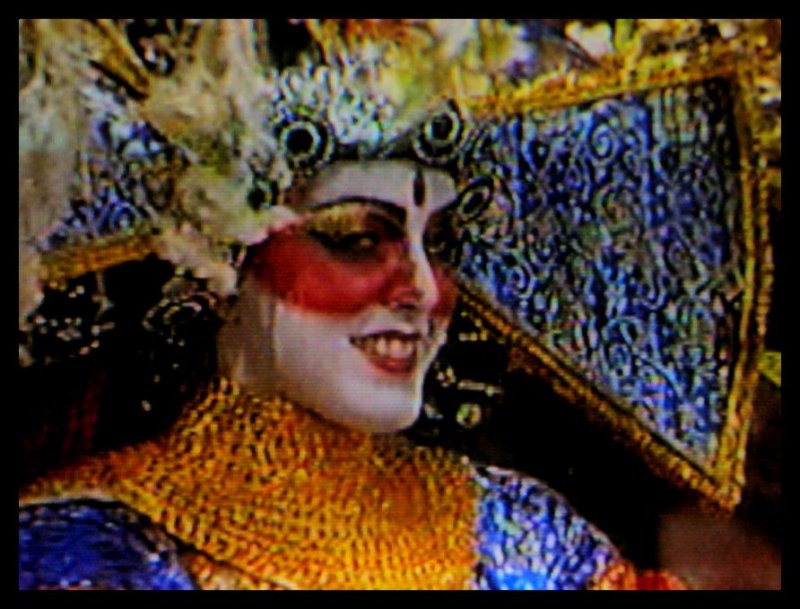Today's tutorial is a short and easy one about setting up a paper sweep for a seamless background behind your subject.
You may have wondered how to eliminate the horizon line between the tabletop and the background. Although you won't want to do this for all your photos, it's useful to know a simple and inexpensive way to give your picture a smooth, even background when you want your dish or other object to stand out on its own.

The answer is called a SWEEP and you've probably seen large backdrops in photo studios where a roll of paper is pulled down from the ceiling and stretched out on the floor towards the camera so the model can stand on the paper and there is no line where floor meets wall.
You can buy white plastic or synthetic material sweeps in small tabletop and larger sizes in photo supply shops and online but as we're trying to keep our experiments down to something you can make at home as economically as possible we're going to make one out of a sheet of white poster paper measuring approx. 20 x 26 inches (50 x 66 cm) bought in a craft or office supply shop. You just have to be careful not to spill gravy too often on the paper!
It helps to wipe carefully the bottom of the dish and put a folded tissue or napkin under before placing it on the paper. I just happen to have a plexiglass recipe book holder..Fig. 31....bought years ago, which not only keeps the pages of a recipe book from being spotted with sauces, but also makes a good support for our poster paper, using two clothes pegs to clip the paper to the holder. Fig. 32. (I hope you still have a few clothes pegs around.)

Another useful item you could use as a support for your sweep is the back part of an old picture frame, Fig. 33 & 33a ...the kind that's made to stand on a table, either vertically or horizontally by its back leg. I removed the glass and frame from an old photo and taped the cardboard backing closed so it holds together. It will also do a good job to support your paper and has the advantage of folding flat and being lightweight.
It can also serve as a holder for a piece of white printer paper ....clipped again with a clothespeg....to be used as a reflector to bounce back the main light onto the dark side of your subject...(when not using it as a support for the sweep paper.)
If you’re really stuck for something to put behind to support your paper sweep, a 5-lb bag of dry cat (or dog) food and two large clothes pegs also does a wonderful job!


Fig. 34 shows how the sweep looks in place behind the teapot, and the following three illustrate the setup with the camera on a tripod.
For this teapot photo I set the SCENE to PORTRAIT, the White Balance (WB) to cloudy, did not raise the Exposure Value (EV), and used the optical zoom on the camera to bring the scene closer.


Fig. 38 shows a piece of white foam packing cut for use as a reflector on the dark side of the teapot. Try to find pieces of fine foam, which come as packing in just about every large item nowadays. The one I show here is the wrong kind, as it leaves bits like popcorn strewn all over the carpet. But I did find some better pieces after I took these photos.
Fig. 39 shows the reflector in place, held by a metal bookend.

Here is the simple metal bookend that can be purchased very reasonably in an office supply shop.

And finally, here you see the difference made by that piece of foam used as a reflector in these two photos. Fig. 41 is without reflector, and Fig. 42 is with.
Of course all shadows aren't bad, because we need shadow to define shapes and show texture and form. But if you are aiming for an all round brightness, the reflector bounces back some of the main light.
In some cases you would also use a softly diffused light from a lamp over on the dark side to give some added highlights.

Here are a few more sample photos which I took using a white or cream coloured paper sweep:




In all cases above the photos were taken in daylight. Next time we'll have a look at artificial lighting and how to take food photos after dark, without flash.
I also want to show you how to make a DIY light box, so you can take closeup photos of food surrounded by pure white light.
Following that, we should get into MACRO mode...it's really easy and it's made for taking closeups just as we're doing here.
I hope you've been experimenting with the White Balance WB and the Exposure Compensation EV buttons.
Until then, thanks for joining me. I'll be uploading the next installment soon,
Sharon (Canarybird)
(All text and photos copyrighted)







2 comments:
Innovative use of seamless background paper ! You are a true artist - creative and resourceful.
Thank you for your visit and your kind comment Patricia!
Post a Comment